When the doors of WCW and ECW were closed forever in 2001, a large window of opportunity was opened in the wrestling community. All it took was one small company named Total Non-Stop Action (TNA), a member of the the National Wrestling Alliance, to cash in on said opportunity, and officially carve its spot in professional wrestling history. SLAM! Wrestling recently talked with some of the people who were there over the course of its journey.
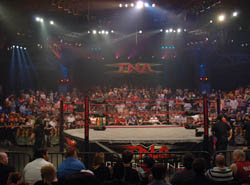
The unique six-sided ring was a calling card of TNA for many years. Photo by Mike Mastrandrea
“When WCW went out of business in 2001, there was a huge void in the marketplace. Vince [McMahon] had bought all the competition. So I started to explore and research a lot of different ideas,” TNA founder Jeff Jarrett told SLAM! Wrestling a few days ago. “The odds of starting up a new company and having it succeed are astronomical. My own family history in the business dates back to the 1940s with my grandmother. I had worked for all the regional territories myself, so I’ve been around the business my whole life. I’ve seen every aspect of it, from the production side to the marketing side to the business side, and I took that knowledge with me as I grew older.”
Having been around the business since childhood, Jarrett teamed with his father, promoter Jerry Jarrett, to get things rolling. They realized that if they were going to accomplish the dream of establishing a national wrestling company, they needed financial security. So enter the Carter family.
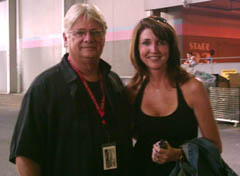
Jerry Jarrett and Dixie Carter. Photo by Bob Kapur
“From day one, we started to look for someone to be in charge of P.R. and marketing. When Dixie [Carter] came in, she immediately blew everyone away, and I ended up hiring her as our P.R. and marketing arm,” Jarrett said. “Bob Carter and his wife ran an energy company [Panda Energy], but Dixie made a name for herself in the entertainment business. She was involved in the music industry in Nashville, so she was a little more familiar with what we did. At the time, our financial investor was coming under scrutiny, so we needed someone to be our financial support. So then Dixie stepped up.”
Looking back at everything that TNA has accomplished in the last 10 years, Dixie Carter could not be prouder that her company is about to reach such a milestone. But there were times at the very beginning, when even she had her doubts.
“Honestly, the tough times I look back on almost as fondly as I do the biggest successes. Would I want to go back to those times? Absolutely not, but when I look back now, I’m very grateful to have had them,” Carter said during a conference call. “And I tell the staff all the time and I tell the wrestlers, I think all of us who have been here from the beginning, we have a different perspective, because we know how hard it was; we know about the challenging times we had. I know the fights that would break out on a Christmas Eve dinner at home over what was happening, and they made me stronger. It has just fueled my passion for having this be successful, and there are no other options.”
TNA first hit the air on June 19, 2002. It was filmed in a small arena in Huntsville, AL. Aside from having a solid financial plan, another big challenge for Jarrett was finding the talent to appear on this show.
“In 2001, a lot of the talent was either under contract to the WWF, or they were wrestling on the indie scene,” Jarrett said. “Putting our roster together was almost like drafting a great professional sports team or casting a great movie.”
Jarrett was clearly on a mission to find the best of the best. So it only seemed natural for him to recruit a man who has competed for every other major promotion — Jerry Lynn.
“I talked to Jeff when we were both in the WWA [World Wrestling All-Stars], and he asked if I’d be on board to help out this new company that he was just starting up,” Lynn said. “In this business, nothing is ever set in stone. The only way I know for sure that a show is happening is when I see my plane ticket.”
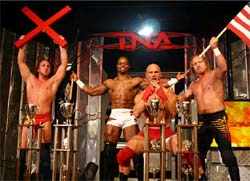
Team TNA, Chris Sabin, Elix Skipper, Christopher Daniels and Jerry Lynn, celebrates their win in the World X-Cup in May 2004. Photo courtesy TNA
Lynn was involved in the first match in company history. He joined Low-Ki, A.J. Styles and Psychosis in a double-elimination four-way dance to crown the first X-Division champion. It all came down to Lynn and Styles as the last two guys, with the legendary Ricky “The Dragon” Steamboat as the guest referee. Lynn looks back at that first match almost as fondly as the fans in attendance, who knew they were witnessing something special.
“It was an honor to be in the ring with such a legend [Steamboat] and AJ and I always kind of joke around because there were so many false finishes in that match, that Steamboat came up to us afterwards and said, ‘You guys are wearing me out,'” Lynn said. “I had fun feuding with AJ when it first started. AJ has always been a great guy who never had an inflated ego.”
Former WWE and MMA star Ken Shamrock won a TNA battle royal, featuring a who’s who of the wrestling business, to become NWA World Heavyweight champion.
“One of the top memories for me is probably the very first show in Huntsville,” said former TNA Senior Official Rudy Charles. “Before TNA, I had just done independent shows, so it was my first exposure to an international stage. Just never having experienced anything like that before, it was very memorable.”
Once the first show went in the record books, more would follow. These shows were produced in a weekly pay per view format and were shot in an arena called The Asylum, in Nashville. It was a unique concept and a bit of a gamble at the time, but once word started to spread, more eyes were locked on TNA wrestling as the weeks rolled by.
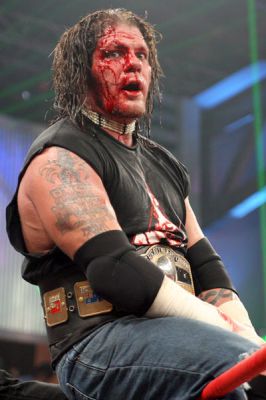
Raven as NWA World champion. Photo courtesy TNA
It was clear at this point, that TNA really needed to establish some main event level talent. Shamrock would not be with the company for too long, so it needed a contingency plan. As a former WCW champion, Jarrett had the most main event experience, so it seemed like a safe bet to position him as the top guy. Vince Russo was later brought in and put together a heel faction to feud with Jarrett, called the Sports Entertainment Xtreme (S.E.X.), which mainly consisted of former WWE and WCW stars. The only thing the group was missing was a clear-cut leader. Of course it had to be someone who could be seen as a serious threat to Jarrett’s title reign. This led to the TNA debut of Raven in 2003. Jarrett and Raven had never worked a program with each other before this, so it was definitely a fresh feud. This was actually the first serious rivalry over the World Title, since the company’s inception. In fact, most World Title matches at the time were booked with only a few weeks notice, but this one had been building for several months.
“The Jeff Jarrett versus Raven match in the Asylum was very memorable,” Charles said. “At the time, it was the biggest match in the company’s history”
TNA was quickly attracting more fans than anyone could have ever imagined. But despite the increasing popularity, management realized that they would eventually have to strike a deal with a major television network.
“I remember there was a time when we knew we had to get off pay per view in the weekly format,” Carter said. “Things needed to change. We needed a television option and things were so bleak. I think that just builds character if you look at it the right way.”
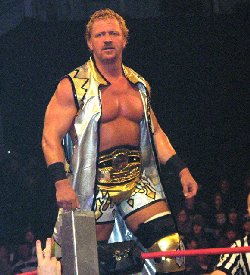
Jeff Jarrett as NWA World champion. Photo by Chris Schramm
That deal was reached with Fox Sports Net in 2004. TNA now had a weekly episodic television series called Impact, in addition to three-hour monthly pay per views. Production was also moved to Universal Studios Theme Park in Orlando, Florida.
“Our head office is still in Nashville, and we originally felt that we weren’t ready to tour. But instead of going to our audience, we let our audience come to us,” Jarrett said. “We moved the show to Orlando and became one of the major attractions of that theme park.”
This was a major change for the company, but would not be the only one, as a brand new hexagon-shaped ring was introduced. It might not have been the easiest change for the talent to get used to, but the fans were solidly behind that decision.
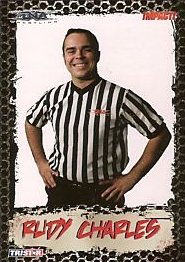
Referee Rudy Charles on a TNA trading card release.
“It was definitely something different. You have to always be aware of where that main camera is. It was a little different getting used to it, but once you did get used to it, it was fine,” Charles said. “I kind of still prefer the six-sided ring. There are a lot of different things you can do with it; especially for the X-Division guys.”
Few would deny that the X-Division has been a critical part of the success of TNA through the years, offering a place for smaller, more agile workers to showcase their talents, often with spectacular results. Innovative matches, like the Ultimate X match or the tournaments.
A new deal could not be reached with Fox Sports Net at the end of that contract, so TNA had no other option but to run Impact from its own website, as a temporary solution. As luck would have it, the company was able to secure an even better deal on a national network, Spike TV, and was positioned in a Saturday night time slot of 11 p.m. EST, with the debut episode on October 1, 2005. Over the course of the next year, Impact was moved to Thursday nights, and was soon changed to 9 p.m. EST.
TNA just continued to grow from there, and eventually, word of mouth spread to other promotions as well. And soon, everyone wanted to be part of this phenomenon.
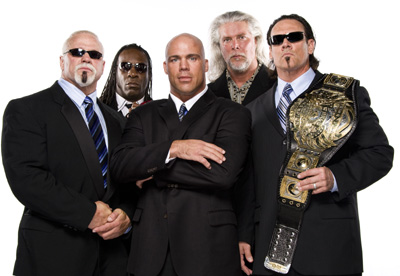
The Main Event Mafia at their apex: Scott Steiner, Booker T, Kurt Angle, Kevin Nash and TNA champion Sting. Photo courtesy TNA
Between 2003 and 2005, TNA was the hottest topic at the water coolers, mainly due to all the fresh faces that were jumping ship from other promotions. This included some legends of the business such as Kevin Nash, Diamond Dallas Page, The Rock ‘N’ Roll Express, Scott Hall, Roddy Piper (made a brief appearance in 2004), and the late Randy “Macho Man” Savage. Also climbing aboard were former WWE stars such as Billy Gunn, Dustin Rhodes and Jeff Hardy. TNA was also attracting such indie sensations as Chris Sabin, Austin Aries, Frankie Kazarian and a man who quickly cannon balled into the X-Division talent pool, Samoa Joe.
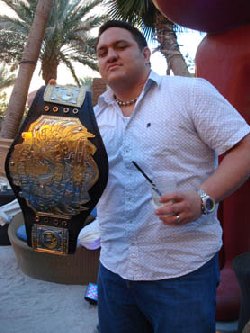
Samoa Joe poses with the TNA World title. Photo by Bob Kapur
“I think TNA needs to concentrate on being the best show that TNA can be. They need to concentrate on putting out the program that’s going to draw the ratings that TNA needs to drive, to succeed and continue to grow and become bigger and better,” Samoa Joe said in 2006, but it is just as true today. “If TNA were worried about war, I think that’s a silly thing. I think there’s plenty of viewers out there for everybody. I’m excited about maybe attracting those viewers who walked away from wrestling”
It was only a matter of time before TNA’s success spread across oceans and borders as well, as the company was also attracting such international stars as Puma, Hector Garza, Juventud Guerrera, Nasawa, Sonjay Dutt and LA Park. The group that perhaps made the biggest impact were the former ECW stars, who were quite used to putting on the performances of their lives in front of a similar fan base. This included The Sandman, Justin Credible, Sabu, the aforementioned Raven and the last ECW Champion Rhino.
“It felt really good to be there,” said former NWA Heavyweight Champion Rhino. “I really enjoyed myself.”
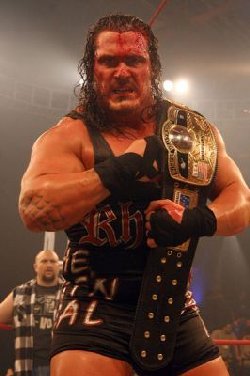
Rhino as as NWA World champion. Photo courtesy TNA
Of all the new stars that were coming in at the time, Rhino probably enjoyed the most success, as he quickly became the NWA World Heavyweight Champion. It was at the company’s first Bound for Glory pay per view in 2005, when Rhino went through three grueling matches to finally accomplish that goal. Even though this may have only been due to Kevin Nash pulling out of the match due to injury, a great time was certainly had by all.
“It was a very long day, but it felt cool to hold a title that a lot of other people have held,” Rhino said. “I actually ended up getting 15 stitches in my head from the guitar shot.”
This level of success was certainly nothing new to Rhino, who had previously competed in two other major promotions. But that wasn’t the case for Roderick Strong, who was finally getting some mainstream exposure. Strong was making a name for himself on the indie scene as sort of a reverse chiropractor, and he came to TNA fully equipped with innovative backbreakers and proved to be a great addition to the X-Division.
“I did one [backbreaker] just for s**** and giggles, just practicing, and everyone kind of reacted to it like, ‘Oh s***!’ So I was like, ‘Maybe I’ve got something here.’ A lot of my offence was totally based on that, but I pick and choose my spots with them, because if they’re not seen as often, obviously the value is a lot higher,” Strong said. “My history with TNA is a little bit longer than it may have seemed. I was on a pay per view in September of 2005, but before that, in 2004 I had some enhancement matches. I disappeared for a while, just because my career outside of that was just starting to blossom.”
From 2005-2008, some of the biggest stars in the history of the business such as Christian Cage, Team 3-D, Kurt Angle, Sting, Booker T. and Mick Foley all took turns riding shotgun on the TNA bandwagon.
“The Jeff Jarrett versus Sting match at Bound for Glory 2006, with Kurt Angle as the special enforcer, was another huge memory for me,” Charles said. “I’ve always been such a big Kurt Angle fan, and to just get to work with him was great. I took an Angle slam from him. Jeff and Sting were both down for the count. I got up to eight or nine, and before I got up to 10, here comes Kurt Angle with the Angle slam, and he takes over as the referee. The fan side of me had a big old smile on the inside.”
In June 2007, it was time for TNA to leave the NWA nest and spread its own wings.
“There were some people in the business who had never heard of us, but everyone had heard of the NWA,” Jarrett said. “Being associated with the NWA kind of gave us some lineage. But once we created our own lineage, we felt it was time for us to be on our own.”
More changes would come by the end of that year. Given the popularity of the high-flying X-Division, inquiring minds have always wondered if that concept could ever be topped. In the fall of 2007, they may have gotten their answer, courtesy of the TNA Knockouts.
“It’s all about girl power in today’s business,” said former TNA Knockouts Champion Taylor Wilde a while back. “Women have proven that they’re no longer a sideshow and have come a long way, since competing in carnivals. I think women can now be looked up to by young girls, and women’s wrestling can no longer be misconstrued as mud wrestling.”
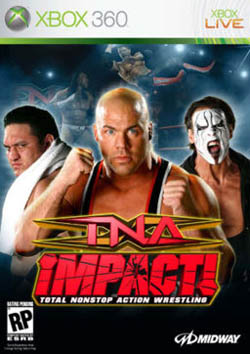
TNA joined forces with Midway Games in 2008 to put out its very own video game called TNA Impact! for Playstation 2 and 3, Xbox 360 and Nintendo Wii. This was in addition to the line of action figures (created by Jakks Pacific) and trading cards that it already had out.
By 2009, TNA had seen many changes, but the best was yet to come. In November of that year, TNA had signed one of the biggest names in the history of wrestling, Hulk Hogan — and he wasn’t coming alone. Hogan was introduced as the new business partner of TNA President Dixie Carter, and would be accompanied by the likes of Ric Flair, Eric Bischoff and a host of others.
“Having Hulk Hogan join us, and as it relates to Hulk, not just as a television personality, but the commitment that he is making behind the scenes … all he’s doing out there has made a tremendous impact on me,” Dixie said.
As if that news wasn’t big enough, TNA took it up a notch and announced that on January 4, 2010, Impact would be going head to head with WWE Raw. It was a bold move on TNA’s part, and unfortunately, it was one that didn’t work out too well, as the show had to be moved back to Thursdays. But it was all just a learning experience for the company that has only made it stronger, moving forward.
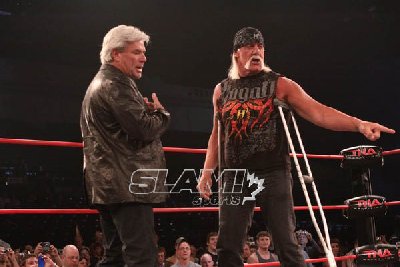
Eric Bischoff and Hulk Hogan at Bound For Glory in October 2010. Photo by George Tahinos
Another big change was the adoption of Impact Wrestling as the company’s upfront branding in early 2011. Hogan, for one, was a big supporter of the change. “It’s a real slow process, but one of the big changes that a lot of people do agree with, and a lot of people don’t agree with, is changing the name. I’ve had several business meetings where I walk in and say, ‘Hey, I’m with TNA Wrestling.’ And if I don’t say it’s Total Nonstop Action, it takes me 10 minutes out of a business meeting to explain what TNA means — and that it’s not a strip club,” Hogan explained to SLAM! Wrestling in May 2011.
Naturally, the wrestling community isn’t always supportive of TNA, critical of the booking decisions, talent acquisitions (and departures), or timeslot changes. But that would go for any company.
The great loyalty that TNA has shown to stars like Styles and Christopher Daniels, or Abyss, who have been with the company for most of its run, cannot be ignored. Even current TNA World champion Bobby Roode can look back to his early days in Scott D’Amore’s Team Canada faction in 2004, meaning he has been with the company for eight long years.
Internationally, TNA has had good success with its tours. Trips to England and Australia have done well, and the company has partnered with Japanese promotions to run the Tokyo Dome. The company’s side project, Ring Ka King, was a huge success.
“Ring Ka King dates back three years. There were several companies in India that wanted to get into wrestling, but for one reason or another, it never really worked out,” Jarrett said. “Endemol had done the research and basically allowed us to do what we do best. We came together on kind of a tag team basis and produced 26 one-hour episodes of high quality entertainment. It was very rewarding for me personally.”
So the question remains: What does the future hold for TNA? The company has already made some major announcements in the last few weeks alone, such as Impact going live all summer long, Brooke Hogan debuting, and the announcement of its very own hall of fame.
The truth is that nobody really knows where the future will take them, but surely everyone hopes for the best.
“We’ve forged new ground in the last decade, and now it’s time to take things to another level,” Jarrett said.
RELATED LINKS

